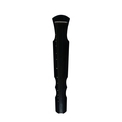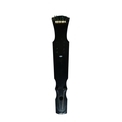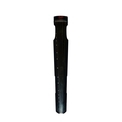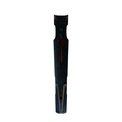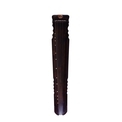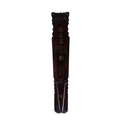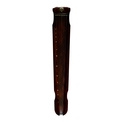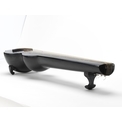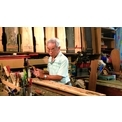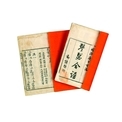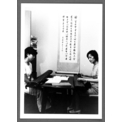The third step of qin making process: hollowing
Inside the top board is the cavity belly, which forms the qin’s resonance box when assembled with the bottom board at the base. The cavity belly needs to be thick in the head and thin in the tail, with a slightly thicker middle axis. The sides should appear curved at the edges, and these should be thinner than the middle. The cavity belly requires different chisels to hollow it out. It is next smoothened with a round plane and a flat plane for conditioning, so that the cavity belly can become rounded and smooth while maintaining the parts of the sound absorbers (nayin) and the feet pools (zhuchi). The thickness and the curvature of the cavity belly affect the qin’s resonance and timbre. When refining and hollowing out the cavity belly, the bottom board has to be fitted over the cavity belly from time to time so that the maker can knock at different parts of the qin body to check the sound’s firmness. The inner side of the bottom board also requires refining to improve its curvature. This photo shows the third step of qin making process which was demonstrated by Choi Chang-sau.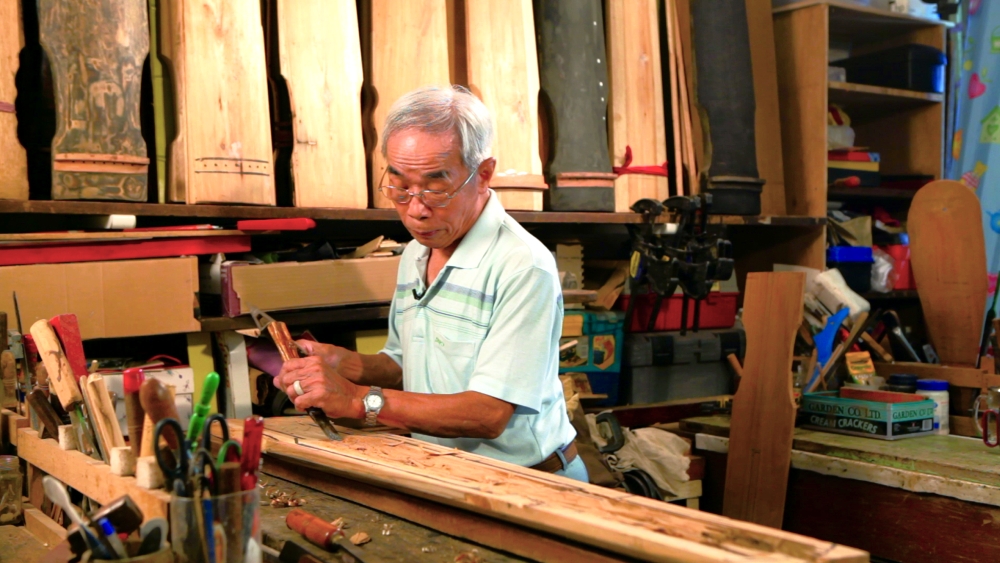
| Date | 2013 |
| People | Choi Chang-sau |
| Material Type | Image |
| Collection | The Legend of Silk and Wood: A Hong Kong Qin Story |
| Source | Intangible Cultural Heritage Office and Hong Kong Heritage Museum |
| Repository | Intangible Cultural Heritage Office |
| Note to Copyright | Permission for use in Hong Kong Memory is given by Intangible Cultural Heritage Office and Hong Kong Heritage Museum |
| Accession No. | lcs-hkqs-0104 |
The third step of qin making process: hollowing
Inside the top board is the cavity belly, which forms the qin’s resonance box when assembled with the bottom board at the base. The cavity belly needs to be thick in the head and thin in the tail, with a slightly thicker middle axis. The sides should appear curved at the edges, and these should be thinner than the middle. The cavity belly requires different chisels to hollow it out. It is next smoothened with a round plane and a flat plane for conditioning, so that the cavity belly can become rounded and smooth while maintaining the parts of the sound absorbers (nayin) and the feet pools (zhuchi). The thickness and the curvature of the cavity belly affect the qin’s resonance and timbre. When refining and hollowing out the cavity belly, the bottom board has to be fitted over the cavity belly from time to time so that the maker can knock at different parts of the qin body to check the sound’s firmness. The inner side of the bottom board also requires refining to improve its curvature. This photo shows the third step of qin making process which was demonstrated by Choi Chang-sau.
| Date | 2013 |
| People | Choi Chang-sau |
| Material Type | Image |
| Collection | The Legend of Silk and Wood: A Hong Kong Qin Story |
| Source | Intangible Cultural Heritage Office and Hong Kong Heritage Museum |
| Repository | Intangible Cultural Heritage Office |
| Note to Copyright | Permission for use in Hong Kong Memory is given by Intangible Cultural Heritage Office and Hong Kong Heritage Museum |
| Accession No. | lcs-hkqs-0104 |
The third step of qin making process: hollowing
Inside the top board is the cavity belly, which forms the qin’s resonance box when assembled with the bottom board at the base. The cavity belly needs to be thick in the head and thin in the tail, with a slightly thicker middle axis. The sides should appear curved at the edges, and these should be thinner than the middle. The cavity belly requires different chisels to hollow it out. It is next smoothened with a round plane and a flat plane for conditioning, so that the cavity belly can become rounded and smooth while maintaining the parts of the sound absorbers (nayin) and the feet pools (zhuchi). The thickness and the curvature of the cavity belly affect the qin’s resonance and timbre. When refining and hollowing out the cavity belly, the bottom board has to be fitted over the cavity belly from time to time so that the maker can knock at different parts of the qin body to check the sound’s firmness. The inner side of the bottom board also requires refining to improve its curvature. This photo shows the third step of qin making process which was demonstrated by Choi Chang-sau.
| Date | 2013 |
| People | Choi Chang-sau |
| Material Type | Image |
| Collection | The Legend of Silk and Wood: A Hong Kong Qin Story |
| Source | Intangible Cultural Heritage Office and Hong Kong Heritage Museum |
| Repository | Intangible Cultural Heritage Office |
| Note to Copyright | Permission for use in Hong Kong Memory is given by Intangible Cultural Heritage Office and Hong Kong Heritage Museum |
| Accession No. | lcs-hkqs-0104 |
The third step of qin making process: hollowing
Inside the top board is the cavity belly, which forms the qin’s resonance box when assembled with the bottom board at the base. The cavity belly needs to be thick in the head and thin in the tail, with a slightly thicker middle axis. The sides should appear curved at the edges, and these should be thinner than the middle. The cavity belly requires different chisels to hollow it out. It is next smoothened with a round plane and a flat plane for conditioning, so that the cavity belly can become rounded and smooth while maintaining the parts of the sound absorbers (nayin) and the feet pools (zhuchi). The thickness and the curvature of the cavity belly affect the qin’s resonance and timbre. When refining and hollowing out the cavity belly, the bottom board has to be fitted over the cavity belly from time to time so that the maker can knock at different parts of the qin body to check the sound’s firmness. The inner side of the bottom board also requires refining to improve its curvature. This photo shows the third step of qin making process which was demonstrated by Choi Chang-sau.
| Date | 2013 |
| People | Choi Chang-sau |
| Material Type | Image |
| Collection | The Legend of Silk and Wood: A Hong Kong Qin Story |
| Source | Intangible Cultural Heritage Office and Hong Kong Heritage Museum |
| Repository | Intangible Cultural Heritage Office |
| Note to Copyright | Permission for use in Hong Kong Memory is given by Intangible Cultural Heritage Office and Hong Kong Heritage Museum |
| Accession No. | lcs-hkqs-0104 |
The third step of qin making process: hollowing
Inside the top board is the cavity belly, which forms the qin’s resonance box when assembled with the bottom board at the base. The cavity belly needs to be thick in the head and thin in the tail, with a slightly thicker middle axis. The sides should appear curved at the edges, and these should be thinner than the middle. The cavity belly requires different chisels to hollow it out. It is next smoothened with a round plane and a flat plane for conditioning, so that the cavity belly can become rounded and smooth while maintaining the parts of the sound absorbers (nayin) and the feet pools (zhuchi). The thickness and the curvature of the cavity belly affect the qin’s resonance and timbre. When refining and hollowing out the cavity belly, the bottom board has to be fitted over the cavity belly from time to time so that the maker can knock at different parts of the qin body to check the sound’s firmness. The inner side of the bottom board also requires refining to improve its curvature. This photo shows the third step of qin making process which was demonstrated by Choi Chang-sau.
| Date | 2013 |
| People | Choi Chang-sau |
| Material Type | Image |
| Collection | The Legend of Silk and Wood: A Hong Kong Qin Story |
| Source | Intangible Cultural Heritage Office and Hong Kong Heritage Museum |
| Repository | Intangible Cultural Heritage Office |
| Note to Copyright | Permission for use in Hong Kong Memory is given by Intangible Cultural Heritage Office and Hong Kong Heritage Museum |
| Accession No. | lcs-hkqs-0104 |
The third step of qin making process: hollowing
Inside the top board is the cavity belly, which forms the qin’s resonance box when assembled with the bottom board at the base. The cavity belly needs to be thick in the head and thin in the tail, with a slightly thicker middle axis. The sides should appear curved at the edges, and these should be thinner than the middle. The cavity belly requires different chisels to hollow it out. It is next smoothened with a round plane and a flat plane for conditioning, so that the cavity belly can become rounded and smooth while maintaining the parts of the sound absorbers (nayin) and the feet pools (zhuchi). The thickness and the curvature of the cavity belly affect the qin’s resonance and timbre. When refining and hollowing out the cavity belly, the bottom board has to be fitted over the cavity belly from time to time so that the maker can knock at different parts of the qin body to check the sound’s firmness. The inner side of the bottom board also requires refining to improve its curvature. This photo shows the third step of qin making process which was demonstrated by Choi Chang-sau.
| Date | 2013 |
| People | Choi Chang-sau |
| Material Type | Image |
| Collection | The Legend of Silk and Wood: A Hong Kong Qin Story |
| Source | Intangible Cultural Heritage Office and Hong Kong Heritage Museum |
| Repository | Intangible Cultural Heritage Office |
| Note to Copyright | Permission for use in Hong Kong Memory is given by Intangible Cultural Heritage Office and Hong Kong Heritage Museum |
| Accession No. | lcs-hkqs-0104 |
The third step of qin making process: hollowing
Inside the top board is the cavity belly, which forms the qin’s resonance box when assembled with the bottom board at the base. The cavity belly needs to be thick in the head and thin in the tail, with a slightly thicker middle axis. The sides should appear curved at the edges, and these should be thinner than the middle. The cavity belly requires different chisels to hollow it out. It is next smoothened with a round plane and a flat plane for conditioning, so that the cavity belly can become rounded and smooth while maintaining the parts of the sound absorbers (nayin) and the feet pools (zhuchi). The thickness and the curvature of the cavity belly affect the qin’s resonance and timbre. When refining and hollowing out the cavity belly, the bottom board has to be fitted over the cavity belly from time to time so that the maker can knock at different parts of the qin body to check the sound’s firmness. The inner side of the bottom board also requires refining to improve its curvature. This photo shows the third step of qin making process which was demonstrated by Choi Chang-sau.
| Date | 2013 |
| People | Choi Chang-sau |
| Material Type | Image |
| Collection | The Legend of Silk and Wood: A Hong Kong Qin Story |
| Source | Intangible Cultural Heritage Office and Hong Kong Heritage Museum |
| Repository | Intangible Cultural Heritage Office |
| Note to Copyright | Permission for use in Hong Kong Memory is given by Intangible Cultural Heritage Office and Hong Kong Heritage Museum |
| Accession No. | lcs-hkqs-0104 |
The third step of qin making process: hollowing
Inside the top board is the cavity belly, which forms the qin’s resonance box when assembled with the bottom board at the base. The cavity belly needs to be thick in the head and thin in the tail, with a slightly thicker middle axis. The sides should appear curved at the edges, and these should be thinner than the middle. The cavity belly requires different chisels to hollow it out. It is next smoothened with a round plane and a flat plane for conditioning, so that the cavity belly can become rounded and smooth while maintaining the parts of the sound absorbers (nayin) and the feet pools (zhuchi). The thickness and the curvature of the cavity belly affect the qin’s resonance and timbre. When refining and hollowing out the cavity belly, the bottom board has to be fitted over the cavity belly from time to time so that the maker can knock at different parts of the qin body to check the sound’s firmness. The inner side of the bottom board also requires refining to improve its curvature. This photo shows the third step of qin making process which was demonstrated by Choi Chang-sau.
| Date of Death | 2013 |
| People | Choi Chang-sau |
| Material Type | Image |
| Collection | The Legend of Silk and Wood: A Hong Kong Qin Story |
| Source | Intangible Cultural Heritage Office and Hong Kong Heritage Museum |
| Repository | Intangible Cultural Heritage Office |
| Note to Copyright | Permission for use in Hong Kong Memory is given by Intangible Cultural Heritage Office and Hong Kong Heritage Museum |
| Accession No. | lcs-hkqs-0104 |
The third step of qin making process: hollowing
Inside the top board is the cavity belly, which forms the qin’s resonance box when assembled with the bottom board at the base. The cavity belly needs to be thick in the head and thin in the tail, with a slightly thicker middle axis. The sides should appear curved at the edges, and these should be thinner than the middle. The cavity belly requires different chisels to hollow it out. It is next smoothened with a round plane and a flat plane for conditioning, so that the cavity belly can become rounded and smooth while maintaining the parts of the sound absorbers (nayin) and the feet pools (zhuchi). The thickness and the curvature of the cavity belly affect the qin’s resonance and timbre. When refining and hollowing out the cavity belly, the bottom board has to be fitted over the cavity belly from time to time so that the maker can knock at different parts of the qin body to check the sound’s firmness. The inner side of the bottom board also requires refining to improve its curvature. This photo shows the third step of qin making process which was demonstrated by Choi Chang-sau.
| Date | 2013 |
| Material Type | Image |
| Collection | The Legend of Silk and Wood: A Hong Kong Qin Story |
| Source | Intangible Cultural Heritage Office and Hong Kong Heritage Museum |
| Note to Copyright | Permission for use in Hong Kong Memory is given by Intangible Cultural Heritage Office and Hong Kong Heritage Museum |
| Accession No. | lcs-hkqs-0104 |
The third step of qin making process: hollowing
Inside the top board is the cavity belly, which forms the qin’s resonance box when assembled with the bottom board at the base. The cavity belly needs to be thick in the head and thin in the tail, with a slightly thicker middle axis. The sides should appear curved at the edges, and these should be thinner than the middle. The cavity belly requires different chisels to hollow it out. It is next smoothened with a round plane and a flat plane for conditioning, so that the cavity belly can become rounded and smooth while maintaining the parts of the sound absorbers (nayin) and the feet pools (zhuchi). The thickness and the curvature of the cavity belly affect the qin’s resonance and timbre. When refining and hollowing out the cavity belly, the bottom board has to be fitted over the cavity belly from time to time so that the maker can knock at different parts of the qin body to check the sound’s firmness. The inner side of the bottom board also requires refining to improve its curvature. This photo shows the third step of qin making process which was demonstrated by Choi Chang-sau.
| Date | 2013 |
| Material Type | Image |
| People | Choi Chang-sau |
| Collection | The Legend of Silk and Wood: A Hong Kong Qin Story |
| Source | Intangible Cultural Heritage Office and Hong Kong Heritage Museum |
| Repository | Intangible Cultural Heritage Office |
| Note to Copyright | Permission for use in Hong Kong Memory is given by Intangible Cultural Heritage Office and Hong Kong Heritage Museum |
| Accession No. | lcs-hkqs-0104 |
Copyright © 2012 Hong Kong Memory


